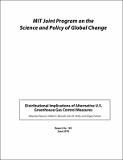Distributional Implications of Alternative U.S. Greenhouse Gas Control Measures
Author(s)
Rausch, Sebastian; Metcalf, Gilbert E.; Reilly, John M.; Paltsev, Sergey
DownloadMITJPSPGC_Rpt185.pdf (974.8Kb)
Metadata
Show full item recordAbstract
We analyze the distributional and efficiency impacts of different allowance allocation schemes for a national cap and trade system using the USREP model, a new recursive dynamic computable general equilibrium model of the U.S. economy. The USREP model tracks nine different income groups and twelve different geographic regions within the United States. Recently proposed legislation include the Waxman-Markey House bill, the similar Kerry-Boxer bill in the Senate that has been replaced by a Kerry-Lieberman draft bill, and the Cantwell-Collins Senate bill that takes a different approach to revenue allocation. We consider allocation schemes motivated by these recent proposals applied to a comprehensive national cap and trade system that limits cumulative greenhouse gas emissions over the control period to 203 billion metric tons. The policy target approximates national goals identified in pending legislation. We find that the allocation schemes in all proposals are progressive over the lower half of the income distribution and proportional in the upper half of the income distribution. Scenarios based on the Cantwell-Collins allocation proposal are less progressive in early years and have lower welfare costs due to smaller redistribution to low income households and consequently lower income-induced increases in energy demand and less savings and investment. Scenarios based on the three other allocation schemes tend to overcompensate some adversely affected income groups and regions in early years but this dissipates over time as the allowance allocation effect becomes weaker. Finally we find that carbon pricing by itself (ignoring the return of carbon revenues through allowance allocations) is proportional to modestly progressive. This striking result follows from the dominance of the sources over uses side impacts of the policy and stands in sharp contrast to previous work that has focused only on the uses side. The main reason is that lower income households derive a large fraction of income from government transfers and, reflecting the reality that these are generally indexed to inflation, we hold the transfers constant in real terms. As a result this source of income is unaffected by carbon pricing, while wage and capital income is affected.
Description
Abstract and PDF report are also available on the MIT Joint Program on the Science and Policy of Global Change website (http://globalchange.mit.edu/)
Date issued
2010-06URI
http://globalchange.mit.edu/pubs/abstract.php?publication_id=2065http://hdl.handle.net/1721.1/57512
Publisher
MIT Joint Program on the Science and Policy of Global Change
Citation
Report no. 185
Series/Report no.
;Report no. 185